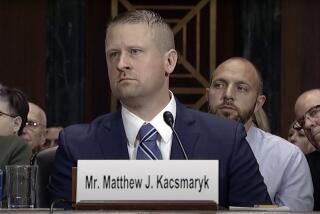A Pro-Choice Answer to ‘Silent Scream’
- Share via
In 1985, there was “The Silent Scream,” the controversial X-ray-like film in which a fetus, described as 12 weeks old, was shown sucking its thumb as it flinched from abortion instruments. Despite efforts by pro-choice advocates to debunk this as “propaganda,” the film proved an effective weapon for the right-to-life movement.
Now, almost four years later, pro-choicers are fighting back with their own videotape, “Abortion: For Survival,” which producer Peg Yorkin calls “an answer to ‘The Silent Scream.’ ”
The answer depicts legalized abortion as a public health issue, rather than one of women’s rights. The video opens with an actual aspiration abortion being performed on a young woman in the first trimester to show it is simple, safe and quick (in this instance, 1 minute and 24 seconds) and that the contents of the uterus at 6 weeks is not a formed fetus but only two tablespoons of blood and tissue.
Right-to-Lifers React
In response, Dan Donehey, director of public relations for national Right-to-Life in Washington, who has seen the video, said: “The point they were trying to make was that what was being aborted is not a baby . . . it’s like pointing to applesauce and saying there’s no apple. Once you’ve run a developing child through a machine that is 29 times more powerful than the household vacuum and shredded it up and you pour it out on a plate and say there’s no baby, I think that’s the ultimate dishonesty.”
Advocating abortion as a backup method of population control, he added, is “cavalier” and “the moral compass of America isn’t pointing in that direction at all.” Monday’s press screening at the Hollywood Roosevelt Hotel was timed to today’s arguments before the U.S. Supreme Court in a Missouri case that will be the most important test of Roe vs. Wade, the 1973 case that struck down anti-abortion laws nationwide.
The new video, produced in Los Angeles by The Fund for the Feminist Majority, will “reshape the debate on abortion,” said Katherine Spillar, the fund’s national coordinator.
Women Told Their Stories
That did not happen four years ago. The response then of the pro-choice movement to “The Silent Scream” was a 30-state speak-out, “Silent No More,” in which women who had had abortions told their stories. To a great extent, a woman’s right to control her own uterus was the focus.
Yorkin, chief producer of the 30-minute video and the feminist fund’s chair, said the new work will “put the lie to a lot of the hysteria from the other side,” including right-to-lifers’ argument that a fetus is a baby from the moment of fertilization.
The video hits hard at the public health issue with statistics from the Allan Guttmacher Institute and the Population Crisis Committee: There were 50 million to 60 million abortions performed worldwide in 1988, about half of them illegal; every three minutes a woman somewhere dies as the result of a botched abortion. It is probable that 46% of all women of child-bearing age will have an abortion; making it illegal does not decrease its incidence.
The video does not duck right-to-life forces’ often-voiced objection to abortion as the “birth control method of choice.” Rather, it emphasizes that abortion is a “necessary back-up to population control,” worldwide the No. 4 form of birth control, after female sterilization, IUDs and the Pill.
It notes that contraception is unavailable or unaffordable for many women, especially in developing countries. Citing Guttmacher figures, the video estimates that 24% to 32% of all pregnancies are terminated by induced abortion.
The video also cites failure rates of birth control methods--18% for sponge with spermicide, 18% for diaphragm with spermicide, 12% for condoms, 6% for IUDs, 3% for the Pill.
Central to the message is that poverty, malnutrition, disease and child abuse result when women lack access to contraception and legal abortion. Placing the debate in a global context, the video notes that the U.S. abortion rate is lower than that worldwide.
Appearing at the screening with Spillar, Yorkin and Toni Carabillo, the feminist fund’s vice president, were two physicians, both USC obstetrics and gynecology professors seen in the video.
Dr. David Grimes, who has conducted research on the controversial French “abortion” pill RU 486, noted that many who oppose legalized abortion also oppose birth control and have put their “chilling mark” on U.S. contraceptive research. He called it “medical McCarthyism.”
A result, he said, is a “reprehensible lack of federal leadership” that has relegated the United States to the “backwaters” of contraception research, leading to “more unwanted pregnancies and, hence, more abortions.”
Abortion Rates
Dr. Keith Russell, former president of the American College of Obstetricians and Gynecologists and the International Federation of Gynecology and Obstetrics, said in an interview afterward that a 6- to 8-week-old fetus is “not a viable pregnancy.” According to the video, 91% of all abortions in the U.S. occur in the first trimester (12 weeks); 50% in the first eight weeks; and only .01% in the third trimester, the latter only for medical reasons.
The debate over “personhood” continues, he said, but legalized abortion is “almost inarguable from a medical standpoint.” It is “generally accepted” in medicine that a human being is first present at “around 26 weeks,” he said.
The video’s objective, Spillar said later, was to portray abortion as “an absolute necessity,” not just a constitutional right. “In truth,” she added, “we don’t expect to change people’s minds” but rather “to inject a new perspective” into the debate. For example, the video argues that adoption, a solution favored by President George Bush, who opposes legalized abortion, is no solution: Adopting parents want perfect Caucasian babies, while 34,000 youngsters in the U.S. await adoption, the vast majority special-needs children or minorities.
The video was given to the U.S. Supreme Court and to 350 members of Congress on lobby day, April 10, the day after the pro-choice march in Washington. It will be shown to state legislators and their staffs this week in California and five other states. It will be distributed on college campuses through women’s groups; to women’s health clinics and nursing and medical schools; and to women’s organizations.
Spillar said production costs of about $60,000 are being covered by donations and she expects the video, at $19.95, to pay for itself, with 1,000 pro-choice groups assisting in distribution.
More to Read
Only good movies
Get the Indie Focus newsletter, Mark Olsen's weekly guide to the world of cinema.
You may occasionally receive promotional content from the Los Angeles Times.










